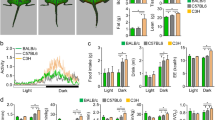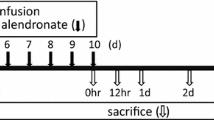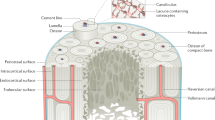Abstract
Therapeutic drugs for osteoporotic patients can be divided into anti-resorptive or anabolic reagents. Eldecalcitol, an analog of active vitamin D3, has been developed in Japan and provides more anti-resorptive effects compared to alfacalcidol—a predrug of eldecalcitol. The anti-resorptive effects of eldecalcitol are reportedly related to the reduced population of preosteoblasts that support osteoclastogenesis, diminished expression of RANKL, and suppressed sphingosine-1-phosphate receptor 2 in circulating osteoclast precursors. Conversely, during the last decade, eldecalcitol has been shown to induce the modeling-based bone formation in trabeculae, i.e., “minimodeling” previously proposed by Frost, in addition to exerting anti-resorptive effects for the osteoporotic treatment. Minimodeling-/modeling-based bone formation is not dependent on foregoing osteoclastic bone resorption; resting osteoblasts, also referred to as bone lining cells, would be activated to deposit new bone on the existing bone. Eldecalcitol-driven minimodeling-/modeling-based bone formation can be seen not only in rodents but also in primates and human patients. Since minimodeling-/modeling-based bone formation is not coupled with osteoclastic bone resorption, eldecalcitol may be able to induce bidirectional function—anti-resorptive effects and anabolic effects mediated by minimodeling-/modeling-based bone formation. In this chapter, studies on the biological effects of eldecalcitol will be introduced.
The present invited review was completed and submitted to the publisher on 24-Feb-20.
Access this chapter
Tax calculation will be finalised at checkout
Purchases are for personal use only
Similar content being viewed by others
References
Amizuka N, Hasegawa T, Oda K, et al. Histology of epiphyseal cartilage calcification and endochondral ossification. Front Biosci. 2012;4:2085–100.
Hasegawa T. Ultrastructure and biological function of matrix vesicles in bone mineralization. Histochem Cell Biol. 2018;149:289–304.
Ozawa H, Hoshi K, Amizuka N. Current concepts of bone mineralization. J Oral Biosci. 2008;50:1–14.
Andreopoulou P, Bockman RS. Management of postmenopausal osteoporosis. Annu Rev Med. 2015;66:329–42.
Okano T, Tsugawa N, Masuda S, et al. Regulatory activities of 2 beta-(3-hydroxypropoxy)-1 alpha, 25-dihydroxyvitamin D3, a novel synthetic vitamin D3 derivative, on calcium metabolism. Biochem Biophys Res Commun. 1989;163:1444–9.
Okano T, Tsugawa N, Masuda S, et al. A novel synthetic vitamin D3 analogue, 2-beta-(3-hydroxypropoxy)-calcitriol (ED-71): its biological activities and pharmacological effects on calcium metabolism. Contrib Nephrol. 1991;91:116–22.
Ono Y, Kawase A, Watanabe H, et al. Syntheses and preventive effects of analogues related to 1alpha,25-dihydroxy-2beta-(3-hydroxypropoxy)vitamin D3 (ED-71) on bone mineral loss in ovariectomized rats. Bioorg Med Chem. 1998;12:2517–23.
Ono Y, Watanabe H, Shiraishi A, et al. Synthetic studies of vitamin D analogs. XXIV. Synthesis of active vitamin D3 analogs substituted at the 2 beta-position and their preventive effects on bone mineral loss in ovariectomized rats. Chem Pharm Bull (Tokyo). 1997;45:1626–30.
de Freitas PHL, Hasegawa T, Takeda S, et al. Eldecalcitol, a second-generation vitamin D analog, drives bone minimodeling and reduces osteoclastic number in trabecular bone of ovariectomized rats. Bone. 2011;49:335–42.
Saito H, Takeda S, Amizuka N. Eldecalcitol and calcitriol stimulates ‘bone minimodeling,’ focal bone formation without prior bone resorption, in rat trabecular bone. J Steroid Biochem Mol Biol. 2013;136:178–82.
Frost HM. Skeletal structural adaptations to mechanical usage (SATMU): 1. Redefining Wolff’s law: the bone modeling problem. Anat Rec. 1990;226:403–13.
Jee WS, Tian XY, Setterberg RB. Cancellous bone minimodeling-based formation: a Frost, Takahashi legacy. J Musculoskelet Neuronal Interact. 2007;7:232–9.
Kobayashi S, Takahashi HE, Ito A, et al. Trabecular minimodeling in human iliac bone. Bone. 2003;32:163–9.
Hatakeyama S, Yoshino M, Eto K, et al. Synthesis and preliminary biological evaluation of 20-epi-eldecalcitol [20-epi-1alpha,25-dihydroxy-2beta-(3-hydroxypropoxy)vitamin D3: 20-epi-ED-71]. J Steroid Biochem Mol Biol. 2010;121:25–8.
Matsumoto T, Takano T, Yamakido S, et al. Comparison of the effects of eldecalcitol and alfacalcidol on bone and calcium metabolism. J Steroid Biochem Mol Biol. 2010;121:261–4.
Kondo S, Takano T, Ono Y, et al. Eldecalcitol reduces osteoporotic fractures by unique mechanisms. J Steroid Biochem Mol Biol. 2015;148:232–8.
Abe M, Tsuji N, Takahashi F, et al. Overview of the clinical pharmacokinetics of eldecalcitol, a new active vitamin D3 derivative. Jpn Pharmacol Ther. 2011;39:261–74.
Sanford M, McCormack PL. Eldecalcitol: a review of its use in the treatment of osteoporosis. Drugs. 2011;71:1755–70.
Hatakeyama S, Nagashima S, Imai N, et al. Synthesis and biological evaluation of a 3-positon epimer of 1alpha,25-dihydroxy-2beta-(3-hydroxypropoxy)vitamin D3 (ED-71). J Steroid Biochem Mol Biol. 2007;103:222–6.
Ritter CS, Brown AJ. Suppression of PTH by the vitamin D analog eldecalcitol is modulated by its high affinity for the serum vitamin D-binding protein and resistance to metabolism. J Cell Biochem. 2011;112:1348–52.
Matsumoto T, Miki T, Hagino H, et al. A new active vitamin D, ED-71, increases bone mass in osteoporotic patients under vitamin D supplementation: a randomized, double-blind, placebo-controlled clinical trial. J Clin Endocrinol Metab. 2005;90:5031–6.
Hasegawa T, Endo T, Tsuchiya E, et al. Biological application of focus ion beam-scanning electron microscopy (FIB-SEM) to the imaging of cartilaginous fibrils and osteoblastic cytoplasmic processes. J Oral Biosci. 2017;59:55–62.
Hasegawa T, Yamamoto T, Hongo H, et al. Three-dimensional ultrastructure of osteocytes assessed by focused ion beam-scanning electron microscopy (FIB-SEM). Histochem Cell Biol. 2018;149:423–32.
Amizuka N, Ozawa H. Intracellular localization and translocation of 1 alpha, 25-dihydroxyvitamin D3 receptor in osteoblasts. Arch Histol Cytol. 1992;55:77–88.
Partridge NC, Frampton RJ, Eisman JA, et al. Receptors for 1,25(OH)2-vitamin D3 enriched in cloned osteoblast-like rat osteogenic sarcoma cells. FEBS Lett. 1980;115(1):139–42.
Narimatsu K, Li M, de Freitas PH, et al. Ultrastructural observation on cells meeting the histological criteria for preosteoblasts--a study in the mouse tibial metaphysis. J Electron Microsc (Tokyo). 2010;59(5):427–36.
Martineau-Doizé B, Lai WH, Warshawsky H, et al. In vivo demonstration of cell types in bone that harbor epidermal growth factor receptors. Endocrinology. 1988;123:841–58.
Rouleau MF, Mitchell J, Goltzman D. Characterization of the major parathyroid hormone target cell in the endosteal metaphysis of rat long bones. J Bone Miner Res. 1990;5:1043–53.
Luiz de Freitas PH, Li M, Ninomiya T, et al. Intermittent PTH administration stimulates pre-osteoblastic proliferation without leading to enhanced bone formation in osteoclast-less c-fos(-/-) mice. J Bone Miner Res. 2009;24:1586–97.
Amizuka N, Takahashi N, Udagawa N, et al. An ultrastructural study of cell-cell contact between mouse spleen cells and calvaria-derived osteoblastic cells in a co-culture system for osteoclast formation. Acta Histochem. Cytochem. 1997;30:351–62.
Suda T, Takahashi N, Udagawa N, et al. Modulation of osteoclast differentiation and function by the new members of the tumor necrosis factor receptor and ligand families. Endocr Rev. 1999;20:345–57.
Yasuda H, Shima N, Nakagawa N, et al. Osteoclast differentiation factor is a ligand for osteoprotegerin/osteoclastogenesis-inhibitory factor and is identical to TRANCE/RANKL. Proc Natl Acad Sci U S A. 1998;95:3597–602.
Uzawa T, Hori M, Ejiri S, Ozawa H. Comparison of the effects of intermittent and continuous administration of human parathyroid hormone (1-34) on rat bone. Bone. 1995;16(4):477–84.
Yamamoto T, Hasegawa T, Sasaki M, et al. Frequency of teriparatide administration affects the histological pattern of bone formation in young adult male mice. Endocrinology. 2016;157:2604–20.
Harada S, Mizoguchi T, Kobayashi Y, et al. Daily administration of eldecalcitol (ED-71), an active vitamin D analog, increases bone mineral density by suppressing RANKL expression in mouse trabecular bone. J Bone Miner Res. 2012;27:461–73.
Sato Y, Miyauchi Y, Yoshida S, et al. The vitamin D analogue ED71 but Not 1,25(OH)2D3 targets HIF1α protein in osteoclasts. PLoS One. 2014;9:e111845.
Kikuta J, Kawamura S, Okiji F, et al. Sphingosine-1-phosphate-mediated osteoclast precursor monocyte migration is a critical point of control in antibone-resorptive action of active vitamin D. Proc Natl Acad Sci USA. 2013;110:7009–13.
Hagino H, Takano T, Fukunaga M, et al. Eldecalcitol reduces the risk of severe vertebral fractures and improves the health-related quality of life in patients with osteoporosis. J Bone Miner Metab. 2013;31:183–9.
Matsumoto T, Ito M, Hayashi Y, et al. A new active vitamin D3 analog, eldecalcitol, prevents the risk of osteoporotic fractures--a randomized, active comparator, double-blind study. Bone. 2011;49:605–12.
Nakamura T, Takano T, Fukunaga M, et al. Eldecalcitol is more effective for the prevention of osteoporotic fractures than alfacalcidol. J Bone Miner Metab. 2013;31:417–22.
Uchiyama Y, Higuchi Y, Takeda S, et al. ED-71, a vitamin D analog, is a more potent inhibitor of bone resorption than alfacalcidol in an estrogen-deficient rat model of osteoporosis. Bone. 2002;30:582–8.
Smith SY, Doyle N, Boyer M, et al. Eldecalcitol, a vitamin D analog, reduces bone turnover and increases trabecular and cortical bone mass, density, and strength in ovariectomized cynomolgus monkeys. Bone. 2013;57:116–22.
Miyauchi Y, Sato Y, Kobayashi T, et al. HIF1α is required for osteoclast activation by estrogen deficiency in postmenopausal osteoporosis. Proc Natl Acad Sci U S A. 2013;110:16568–73.
Parfitt AM. The cellular basis of bone remodeling: The quantum concept reexamined in light of recent advances in the cell biology of bone. Calcifi Tissue Int. 1984;36:S37–45.
Parfitt AM. The physiologic and clinical significance of bone histomorphometricaal data. In: Recker RR, editor. Bone histomorphometry: techniques and interpretation. Boca Raton: CRC Press; 1983. p. p143–223.
Baron R, Tross R, Vignery A. Evidence of sequential remodeling in rat trabecular bone: morphology, dynamic histomorphometry, and changes during skeletal maturation. Anat Rec. 1984;208:137–45.
Erben RG. Trabecular and endocortical bone surfaces in the rat: modeling or remodeling? Anat Rec. 1996;246:39–46.
Hasegawa T, Yamamoto T, Sakai S. Histological effects of the combined administration of eldecalcitol and a parathyroid hormone in the metaphyseal trabeculae of ovariectomized rats. J Histochem Cytochem. 2019;67:169–84.
Shiraki M, Saito H, Matsumoto T. Eldecalcitol normalizes bone turnover markers regardless of their pre-treatment levels. Curr Med Res Opin. 2012;28:1547–52.
Sakai S, Hongo H, Yamamoto T, et al. Sequential treatment with eldecalcitol after PTH improves bone mechanical properties of lumbar spine and femur in aged ovariectomized rats. Calcif Tissue Int. 2019;104:251–61.
Shiraishi A, Takeda S, Masaki T, et al. Alfacalcidol inhibits bone resorption and stimulates formation in an ovariectomized rat model of osteoporosis: distinct actions from estrogen. J Bone Miner Res. 2000;15:770–9.
Okuda N, Takeda S, Shinomiya K, et al. ED-71, a novel vitamin D analog, promotes bone formation and angiogenesis and inhibits bone resorption after bone marrow ablation. Bone. 2007;40:281–92.
Chen H, Tian X, Liu X, et al. Alfacalcidol-stimulated focal bone formation on the cancellous surface and increased bone formation on the periosteal surface of the lumbar vertebrae of adult female rats. Calcif Tissue Int. 2008;82:127–36.
Li M, Healy DR, Li Y, et al. Alfacalcidol prevents age-related bone loss and causes an atypical pattern of bone formation in aged male rats. J Musculoskelet Neuronal Interact. 2004;4:22–32.
Liu XQ, Chen HY, Tian XY, et al. Alfacalcidol treatment increases bone mass from anticatabolic and anabolic effects on cancellous and cortical bone in intact female rats. J Bone Miner Metab. 2008;26:425–35.
Ubaidus S, Li M, Sultana S, et al. FGF23 is mainly synthesized by osteocytes in the regularly distributed osteocytic lacunar canalicular system established after physiological bone remodeling. J Electron Microsc (Tokyo). 2009;58(6):381–92.
Saito M, Grynpas MD, Burr DB, et al. Treatment with eldecalcitol positively affects mineralization, microdamage, and collagen crosslinks in primate bone. Bone. 2015;73:8–15.
Hikata T, Hasegawa T, Horiuchi K, et al. Histomorphometric analysis of minimodeling in the vertebrae in postmenopausal patients treated with anti-osteoporotic agents. Bone Rep. 2016;5:286–91.
Author information
Authors and Affiliations
Corresponding author
Editor information
Editors and Affiliations
Rights and permissions
Copyright information
© 2022 Springer Nature Singapore Pte Ltd.
About this chapter
Cite this chapter
Hasegawa, T., Hongo, H., Yamamoto, T., Amizuka, N. (2022). Morphological Assessment of the Biological Effects of Eldecalcitol. In: Takahashi, H.E., Burr, D.B., Yamamoto, N. (eds) Osteoporotic Fracture and Systemic Skeletal Disorders. Springer, Singapore. https://doi.org/10.1007/978-981-16-5613-2_27
Download citation
DOI: https://doi.org/10.1007/978-981-16-5613-2_27
Published:
Publisher Name: Springer, Singapore
Print ISBN: 978-981-16-5612-5
Online ISBN: 978-981-16-5613-2
eBook Packages: MedicineMedicine (R0)




